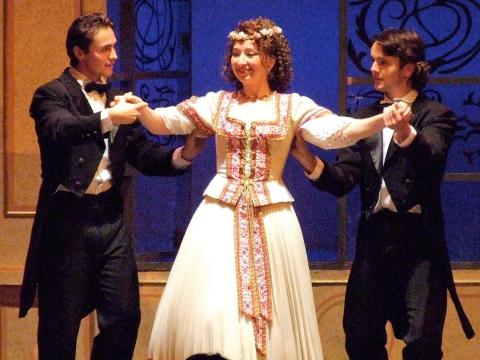|

Viennese Pastry
Franz Lehár's 'The Merry Widow',
reviewed by SUSAN HAMPTON
It was The Merry Widow, or Die Lustige Witwe that made Franz Lehár (1870-1948) a familiar name among operetta composers. Lehár, the son of an army band master, was born in Komárno in what is now Slovakia. He studied violin and composition at the Prague Conservatory where Antonin Dvorák recognized his talent for composition and advised him to spend more time writing music and less practicing the fiddle. When Lehár graduated in 1899, he joined the army and was soon presented with a large orchestra to conduct. Eventually, he was sent to Vienna where he composed a waltz for Princess Metternich's Gold and Silver Ball that became enormously popular.

Dancers from Teatro Lirico D'Europa with Christin Molnar in the title role of Franz Lehár's 'The Merry Widow'. Photo © 2007 Robin Grant
|
He then left the military and began to conduct at the Theater an der Wien. His first work for the stage, Wiener Frauen, was produced there with modest success in 1902. That same year his Der Rastelbinder was seen at a rival theatre and he found himself less than welcome as a conductor at the Theater an der Wien. From then on, he would live on his earnings as a freelance composer. He worked hard and completed two more moderately successful operettas that were staged in 1904. In 1905 he had a major success with The Merry Widow which brought him superstar status when it took Central Europe by storm. Two years later, it was at Daly's Theatre in London and at the New Amsterdam Theatre in New York City.
Continue >>
Copyright © 4 December 2007
Susan Hampton, Los Angeles, USA

|

